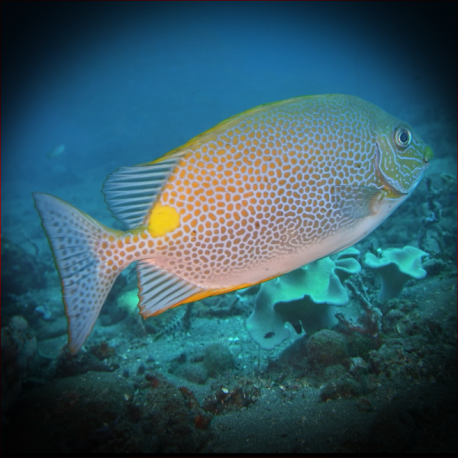More info
Datasheet
| Minimum Tank Size | 1200 litres / 317.01 US gallons |
| Maximum Size | 42.0cm / 16.54inches |
| Reef Compatible | Often reef safe |
| Temperament | Mostly peaceful but might be aggressive towards similar species |
| Temperature | 22.2°C / 71.96°F - 25.6°C / 78.08°F |
| Specific Gravity | 1.020-1.025 |
| Carbonate Hardness | 8-12 |
| pH | 8.1-8.4 |
General Description
The Goldlined spinefoot, scientifically known as Siganus guttatus, is a member of the Siganidae family. These fish are commonly referred to by various names including Golden rabbit fish, Gold-saddle rabbitfish, and Orange-spotted spinefoot. They are native to the Eastern Indian Ocean and Western Pacific regions and can grow up to a maximum size of 42.0cm. Goldlined spinefoots are recognized for their venomous properties, with toxins that can cause considerable pain if handled improperly.
Aquarium Suitability
Considered suitable for most aquarium setups, Goldlined spinefoots are generally hardy and can adapt well to captive environments. However, they are not recommended for small tanks due to their need for ample swimming space. These fish are peaceful for the most part but may display aggression towards similar species, making it important to monitor tank mates closely. It is essential to note that Goldlined spinefoots have toxic spines on their backs, posing a potential risk if precautions are not taken.
Demands, Care, and Hardiness
Goldlined spinefoots are hardy creatures that thrive in well-established aquariums with plenty of algae for grazing. Providing a diet rich in algae-based foods such as plant-based fish flakes or Nori seaweed is crucial for their immune system and overall health. These fish are effective algae eaters, aiding in the control of algae growth within the tank. To ensure their well-being, it is recommended to have a well-run aquarium with sufficient algae on rocks and stones for them to feed on.
Reef Suitability
Goldlined spinefoots are often considered reef safe when well fed; however, they may nibble on soft coral and LPS if food sources are scarce. They can contribute to algae control in reef environments but should be monitored to prevent any damage to corals or other inhabitants. Reef setups with abundant algae growth can provide a suitable habitat for Goldlined spinefoots to thrive.
Aquarium Setup
When setting up an aquarium for Goldlined spinefoots, it is crucial to provide a spacious environment with adequate swimming room. Incorporating rocks and stones with algae growth will mimic their natural habitat and encourage their grazing behavior. Maintaining stable water conditions with a pH range of 8.1-8.4, a specific gravity of 1.020-1.025, and a temperature between 22.2-25.6°C is essential for their well-being.
Behaviour
Goldlined spinefoots are known to change color when frightened, often becoming pale or brownish as a defense mechanism. They have a peaceful temperament but may exhibit territorial behavior towards similar species. Observing their interactions and ensuring that they have enough space to establish their territories can help maintain a harmonious tank environment.
Feeding and Diet
These fish primarily feed on small crustaceans such as krill, mysis, and artemia, but their diet should be supplemented with algae-rich foods. Macroalgae like seaweed and microalgae such as spirulina are recommended dietary staples for Goldlined spinefoots. Ensuring a well-rounded and algae-focused diet will support their nutritional needs and overall health.
Habitat and Distribution
Goldlined spinefoots are commonly found in regions spanning from the Andaman Islands to the Philippines and Palau in the East Indian Ocean and Western Pacific. They inhabit areas with rocky substrates abundant in algae, where they can graze and seek shelter. Understanding their natural habitat and feeding habits is essential for recreating a suitable environment in captivity.

